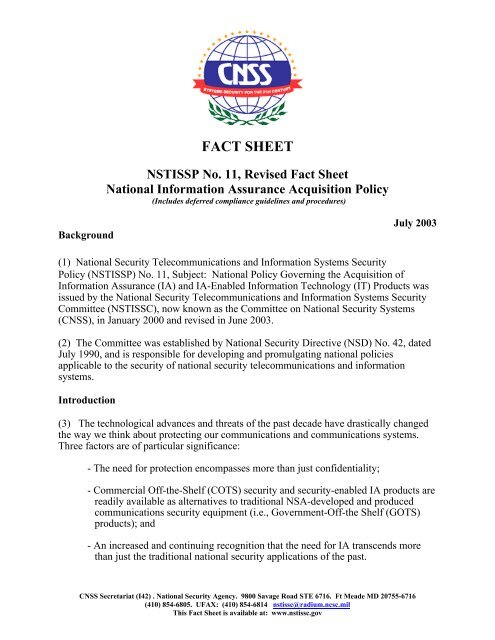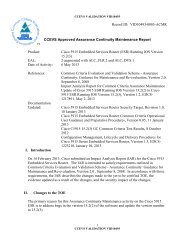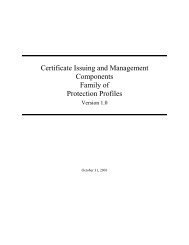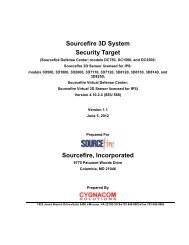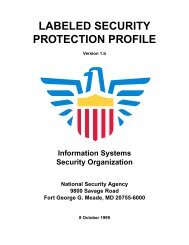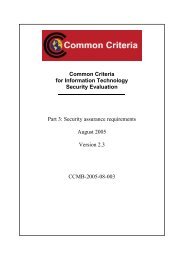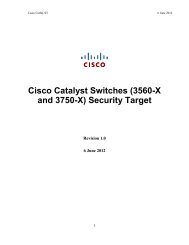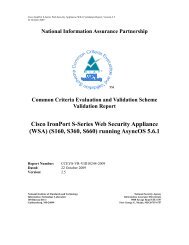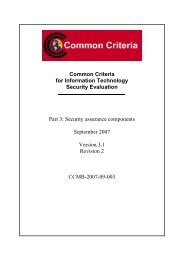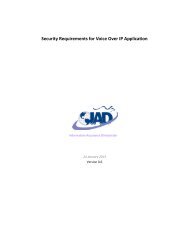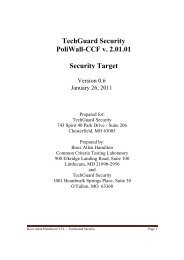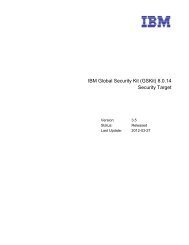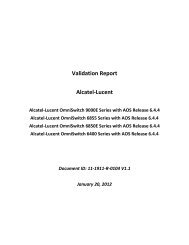NSTISSP No. 11, Revised Fact Sheet - Common Criteria Evaluation ...
NSTISSP No. 11, Revised Fact Sheet - Common Criteria Evaluation ...
NSTISSP No. 11, Revised Fact Sheet - Common Criteria Evaluation ...
You also want an ePaper? Increase the reach of your titles
YUMPU automatically turns print PDFs into web optimized ePapers that Google loves.
FACT SHEET<br />
<strong>NSTISSP</strong> <strong>No</strong>. <strong>11</strong>, <strong>Revised</strong> <strong>Fact</strong> <strong>Sheet</strong><br />
National Information Assurance Acquisition Policy<br />
(Includes deferred compliance guidelines and procedures)<br />
Background<br />
July 2003<br />
(1) National Security Telecommunications and Information Systems Security<br />
Policy (<strong>NSTISSP</strong>) <strong>No</strong>. <strong>11</strong>, Subject: National Policy Governing the Acquisition of<br />
Information Assurance (IA) and IA-Enabled Information Technology (IT) Products was<br />
issued by the National Security Telecommunications and Information Systems Security<br />
Committee (NSTISSC), now known as the Committee on National Security Systems<br />
(CNSS), in January 2000 and revised in June 2003.<br />
(2) The Committee was established by National Security Directive (NSD) <strong>No</strong>. 42, dated<br />
July 1990, and is responsible for developing and promulgating national policies<br />
applicable to the security of national security telecommunications and information<br />
systems.<br />
Introduction<br />
(3) The technological advances and threats of the past decade have drastically changed<br />
the way we think about protecting our communications and communications systems.<br />
Three factors are of particular significance:<br />
- The need for protection encompasses more than just confidentiality;<br />
- Commercial Off-the-Shelf (COTS) security and security-enabled IA products are<br />
readily available as alternatives to traditional NSA-developed and produced<br />
communications security equipment (i.e., Government-Off-the Shelf (GOTS)<br />
products); and<br />
- An increased and continuing recognition that the need for IA transcends more<br />
than just the traditional national security applications of the past.<br />
CNSS Secretariat (I42) . National Security Agency. 9800 Savage Road STE 6716. Ft Meade MD 20755-6716<br />
(410) 854-6805. UFAX: (410) 854-6814 nstissc@radium.ncsc.mil<br />
This <strong>Fact</strong> <strong>Sheet</strong> is available at: www.nstissc.gov
<strong>NSTISSP</strong> <strong>No</strong>. <strong>11</strong>, <strong>Revised</strong> <strong>Fact</strong> <strong>Sheet</strong><br />
July 2003<br />
(4) In the context of the second sub-bullet of paragraph (3), it is important that COTS<br />
products acquired by U.S. Government Departments and Agencies be subject to a<br />
standardized evaluation process, which will provide some assurances that these products<br />
perform as advertised. Accordingly, <strong>NSTISSP</strong> <strong>No</strong>. <strong>11</strong> has been developed as a means of<br />
addressing this problem for those products acquired for national security applications.<br />
<strong>NSTISSP</strong> <strong>No</strong>. <strong>11</strong> also rightfully points out that protection of systems encompasses more<br />
than just acquiring the right product. Once acquired, these products must be integrated<br />
properly and subject to an accreditation process, which will ensure total integrity of the<br />
information and systems to be protected.<br />
Policy<br />
(5) IA shall be considered as a requirement for all systems used to enter, process, store,<br />
display, or transmit national security information. IA shall be achieved through the<br />
acquisition and appropriate implementation of evaluated or validated GOTS or COTS IA<br />
and IA-enabled IT products. These products should provide for the availability of the<br />
systems, ensure the integrity and confidentiality of information, and ensure the<br />
authentication and non-repudiation of parties in electronic transactions.<br />
(6) On 1 January 2001, preference was to be given to the acquisition of COTS IA and<br />
IA-enabled IT products (to be used on systems entering, processing, storing, displaying,<br />
or transmitting national security information) which had been evaluated and validated, as<br />
appropriate, in accordance with:<br />
- The International <strong>Common</strong> <strong>Criteria</strong> for Information Security Technology<br />
<strong>Evaluation</strong> Mutual Recognition Arrangement;<br />
- The National Security Agency (NSA) /National Institute of Standards and<br />
Technology (NIST) National Information Assurance Partnership (NIAP)<br />
<strong>Evaluation</strong> and Validation Program; or<br />
- The NIST Federal Information Processing Standard (FIPS) validation program.<br />
(7) Effective 1 July 2002, the acquisition of all COTS IA and IA-enabled IT products to<br />
be used on the systems specified in paragraph (6), shall be limited only to those which<br />
have been evaluated and validated in accordance with the criteria, schemes, or programs<br />
specified in the three sub-bullets of paragraph (6).<br />
(8) The evaluation/validation of COTS IA and IA-enabled IT products will be<br />
conducted by accredited commercial laboratories, or the NIST.<br />
(9) The acquisition of all GOTS IA and IA-enabled products to be used on systems<br />
entering, processing, storing, displaying, or transmitting national security information<br />
2
<strong>NSTISSP</strong> <strong>No</strong>. <strong>11</strong>, <strong>Revised</strong> <strong>Fact</strong> <strong>Sheet</strong><br />
July 2003<br />
shall be limited to products which have been evaluated by NSA, or in accordance with<br />
NSA-approved processes.<br />
(10) <strong>No</strong>rmally, a complementary combination of IA/IA-enabled products is needed to<br />
provide a complete security solution to a given environment. Thus, in addition to<br />
employing evaluated and validated IA/IA-enabled products, a solution security analysis<br />
should be conducted as part of the certification and accreditation process. In support of<br />
this, NSA shall provide guidance regarding the appropriate combinations and<br />
implementation of GOTS and COTS IA and IA-enabled products.<br />
(<strong>11</strong>) Subject to policy and guidance for non-national security systems, departments and<br />
agencies may wish to consider the acquisition and appropriate implementation of<br />
evaluated and validated COTS IA and IA-enabled IT products. The use of these products<br />
may be appropriate for systems which process, store, display, or transmit information<br />
that, although not classified, may be critical or essential to the conduct of organizational<br />
missions, or for information or systems which may be associated with the operation<br />
and/or maintenance of critical infrastructures as defined in Presidential Decision<br />
Directive <strong>No</strong>. 63 (PDD-63), Critical Infrastructure Protection, dated 22 May 1998.<br />
Responsibilities<br />
(12) Heads of U.S. Departments and Agencies are responsible for ensuring compliance<br />
with the requirements of this policy.<br />
Exemptions and Deferred Compliance<br />
(13) COTS or GOTS IA and IA-enabled IT products acquired prior to the effective dates<br />
prescribed herein shall be exempt from the requirements of this policy. Information<br />
systems in which those products are integrated should be operated with care and<br />
discretion and evaluated/validated IA products and solutions considered as replacement<br />
upgrades at the earliest opportunity.<br />
(14) While COTS IA and IA-enabled products (non-encryption based) have been<br />
developed, evaluated, and are available for acquisition and implementation on national<br />
security systems, it is recognized that these products do not cover the full range of<br />
potential user applications. Rapid technologic changes and the amount of time it takes to<br />
successfully complete a product evaluation also affect compliance with <strong>NSTISSP</strong> <strong>No</strong>. <strong>11</strong>.<br />
Therefore, full and immediate compliance with <strong>NSTISSP</strong> <strong>No</strong>. <strong>11</strong> may not be possible for<br />
all acquisitions.<br />
(15) <strong>No</strong> blanket or open-ended waivers to <strong>NSTISSP</strong> <strong>No</strong>. <strong>11</strong> will be authorized, but a<br />
Deferred Compliance Authorization (DCA) 1 may be granted on a case-by-case basis.<br />
1 A Deferred Compliance Authorization (DCA) is a formal approval by an authorized official to defer compliance<br />
with the requirements of a national IA policy for a specified period of time, normally not to exceed more than one<br />
calendar year.<br />
3
<strong>NSTISSP</strong> <strong>No</strong>. <strong>11</strong>, <strong>Revised</strong> <strong>Fact</strong> <strong>Sheet</strong><br />
July 2003<br />
Departments and agencies electing to pursue a DCA from the policy requirements of<br />
<strong>NSTISSP</strong> <strong>No</strong>. <strong>11</strong>, shall use the following guidelines when determining whether a DCA is<br />
appropriate for a particular application and, if so, who has the authority for reviewing and<br />
approving a requested DCA.<br />
Deferred Compliance Guidance<br />
(16) The issuance of a DCA will apply only to environments not requiring the encryption<br />
of classified information. A DCA will not be submitted for encryption products.<br />
Encryption products for protecting classified information will be certified by NSA, and<br />
encryption products intended for protecting sensitive information will be certified in<br />
accordance with NIST FIPS 140-2.<br />
(17) A DCA is applicable only to the acquisition of a specific COTS product for a<br />
specific application within the IT enterprise of an organization. It does not constitute<br />
blanket approval for future acquisitions of the same product and does not obviate the<br />
requirement for the requesting organization to obtain necessary certification and<br />
accreditation approval for the application or system in which the product will be used<br />
prior to operational use. A record of all DCAs will be included in certification and<br />
accreditation documentation.<br />
(18) A DCA will be reviewed and approved only by the heads of federal departments or<br />
agencies, or major subordinate organizations with a department or agency (e.g., the<br />
Defense Intelligence Agency (DIA) within the Department of Defense). Heads of<br />
departments or agencies (or major subordinate organizations) may delegate their DCA<br />
review and approval authorities to a designee within their respective organizations. This<br />
normally would be the Chief Information Officer (CIO) or equivalent, or any other<br />
individual responsible for the security of the overall IT enterprise within that department<br />
or agency. Delegations of DCA authority must be formalized in writing and their<br />
currency maintained.<br />
Deferred Compliance Procedures<br />
(19) Those individuals or organizations (These could include IA/IT planners, designers,<br />
integrators, as well as acquisition entities.) responsible for IA within their respective<br />
departments or agencies will determine whether an evaluated product (or products) is<br />
available to satisfy a particular requirement.<br />
(20) If an evaluated product is not available, DCA documentation will be prepared and<br />
submitted to the DCA approving authority. The DCA documentation must contain the<br />
following information:<br />
4
<strong>NSTISSP</strong> <strong>No</strong>. <strong>11</strong>, <strong>Revised</strong> <strong>Fact</strong> <strong>Sheet</strong><br />
July 2003<br />
- A description of the intended application and type of product needed;<br />
- Details of why an evaluated product is not being procured (e.g., no products of<br />
this type have been evaluated, or an explanation as to why available evaluated<br />
products do not meet user’s functional or security requirements);<br />
- Product information, ideally the product’s Security Target (i.e., the security<br />
claims being made by the vendor), and evidence (as documented by an<br />
appropriate department or agency testing facility) that the product’s features and<br />
assurances are adequate for the intended application;<br />
- The product quantity that is being acquired; and<br />
- A statement that the requesting department or agency will, as a condition of<br />
purchase, require the product and its associated Security Target to be submitted<br />
for evaluation and validation to a <strong>Common</strong> <strong>Criteria</strong> Testing Laboratory<br />
accredited by the NSA/NIST NIAP <strong>Evaluation</strong> and Validation Program or a<br />
member nation recognized under the International <strong>Common</strong> <strong>Criteria</strong> for<br />
Information Technology Security <strong>Evaluation</strong> Security Mutual Recognition<br />
Arrangement.<br />
(21) The Certifiers and Accreditors of systems that are relying on the security features<br />
and assurances of a product submitted and approved for a DCA should recognize that the<br />
security claims of the product have yet to be independently validated and therefore,<br />
should consider issuing Interim Approval to Operate (IATO) rather than Approval to<br />
Operate (ATO) for these systems.<br />
(22) In the event an installed product fails to meet established validation and certification<br />
testing requirements during the period of the authorized DCA, it is recommended that<br />
Certifiers and Accreditors take steps to remove the product from national security<br />
systems falling under their purview. As with any security decision, the CIO (or<br />
equivalent authority) has the option of authorizing continued use of the failed product and<br />
accepting the risk of continued use, but should mandate follow-on actions that will ensure<br />
that the product is evaluated and validated for use on a national security system. Such<br />
“continue to operate” decisions should be formally documented and included in the<br />
overall system certification and accreditation documentation.<br />
(23) The DCA approving authority will review and approve the DCA and submit the<br />
DCA documentation to the CNSS Secretariat through the Information Assurance<br />
Directorate (IAD) of the National Security Agency:<br />
National Security Agency<br />
5
<strong>NSTISSP</strong> <strong>No</strong>. <strong>11</strong>, <strong>Revised</strong> <strong>Fact</strong> <strong>Sheet</strong><br />
July 2003<br />
ATTN: V1<br />
Suite 6740<br />
Ft. George G. Meade, MD 20755-6740<br />
V1 may also be contacted via commercial phone at 410-545-4384 or fax at 410-854-<br />
6615.<br />
6


